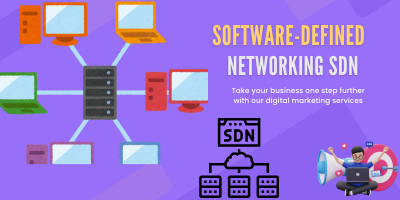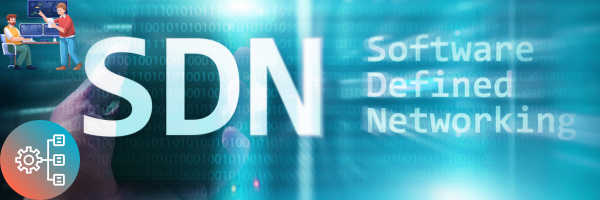What Is Software-Defined Networking SDN: A Complete Guide
Published: September 20, 2025

What Is Software-Defined Networking SDN today’s incredibly agile world has raised the importance of effective and agile network management. The networking systems in use in most cases become areas of scale and complexity that are extremely hard to manage. Sandbox adaptations help in framing Software Defined Networking SDN systems, meeting architectural simplifications in building, managing, and optimizing networks. The architectural design of SDN helps in removing the control and data planes. This enhances system flexibility, ease of scaling, and resource optimization. What does this mean to the world of an average individual and an organization? What does this mean to other networking systems?
In this article, we will go over the world of SDN, talking about everything from its components to how it functions and the importance it holds today, in full detail. Whether you are someone working in a networking system professionally who is looking to build on your skill set, or you are curious to know how networking would look in the years to come, we will make everything in email very digestible. By the end of the entire guide, you will have a better understanding of SDN. You will also have strategic steps on how to use it for better network management.
It is essential to understand the fundamental principles and benefits of SDN as its adoption expands in sectors such as enterprise IT and data centers. However, like all solutions, SDN also has its drawbacks. We’ll try to identify the drawbacks, so you’ll have a clearer picture to balance the benefits and disadvantages. SDN, and the benefits it brings, along with its many accompanying challenges, are now a fact of life. It is time to start learning about SDN and how it is changing the entire world of networking.
Table of Contents
- What is Software-Defined Networking (SDN)?
- What are the Components of Software-Defined Networking (SDN)?
- Where is Software-Defined Networking Used?
- Why is Software-Defined Networking Important?
- How Does Software-Defined Networking (SDN) Work?
- What are the Different Models of SDN?
- Difference Between SDN and Traditional Networking
- Advantages of SDN
- Disadvantages of SDN
What Is Software-Defined Networking (SDN)?

What Is Software-Defined Networking SDN is the approach to network management that most easily separates a network’s control and hardware components. In so doing, it fosters a network environment that is more agile and dynamic. In networking as it is practiced today, each hardware unit (switches, routers, etc.) simultaneously does both data forwarding and decision making. In SDN, the decision-making is performed in a software ‘controller’ somewhere and is then sent down to the hardware.
What Is Software-Defined Networking SDN unparalleled capability is attributed to the splitting of the control and data planes. The control plane is responsible for keeping the flow of traffic, and the data plane deals with the routing of the packets to the intended receiver. The control plane’s SDN centralizes and enables the administrator to control the plane’s broad strategic upwards and the network in real-time without the need to manually configure the hardware.
This change enables advanced network management, which is very important for large and complex systems. The Ethernet SDN is designed for enterprises and their sprawling networks, offering easy configuration, automation, and meeting modern network demands. The SDN makes the network dynamic, meaning the Ethernet configuration complements remote management to increase wiring dependability, reduce alterations to cloud computing systems, and decrease maintenance overhead.
What Are The Components of Software-Defined Networking (SDN)?

Three components make up SDN: the application layer, the control layer, and the data layer. These are the components from which SDN’s effectiveness is derived.
1. Application Layer
What Is Software-Defined Networking SDN this is where all network services and applications are designed. This layer interacts with the control plane and sets up on the network the resources needed to implement the applications. For example, if the cloud application is designed to set up and demand the bandwidth, it uses dynamic SDN to reconfigure the application layer.
2. Control Layer
What Is Software-Defined Networking SDN to put it simply, the ‘Control Layer’ is the central part of the SDN and is known as the SDN Controller. It takes into consideration how data flows through the network and works as the ‘brain’ of the network. As it stands, the SDN Controller is capable of dynamically adjusting routing paths and managing resources as per the real-time requirements to optimize the overall performance and faster response times.
3. Data Layer
What Is Software-Defined Networking SDN the data layer comprises a collection of SDN and physical network devices, often referred to as switches and routers. These devices are simplified in SDN, as they do not determine on what basis the data will be processed. Instead, they respond to the ‘Control Layer’ and do as instructed. Such a division helps streamline operations and manage networks more easily on a larger scale.
Where is Software-Defined Networking Used?
What Is Software-Defined Networking SDN the flexibility, real-time control, and SDN scale defined SDN usage in a variety of environments. These are the general use cases:
1. Data Centers
What Is Software-Defined Networking SDN having SDN in data centers is beneficial, as maintaining and overseeing a large scale of resources is crucial. With the SDN, data centers can automatically provision virtual machines, optimize traffic management, and control bandwidth with ease.
2. Cloud Environments
Cloud service providers utilize SDN for the effective management and scaling of their networks. With the SDN, the prompt setup of resources supported by optimal resource distribution guarantees that cloud services can seamlessly meet the shifting demands without manual control or downtime.
3. Enterprise Networks
What Is Software-Defined Networking SDN for several large enterprises, SDN facilitates the centralized administration of extensive networks that are physically dispersed. The technology can automate the setting of specific network parameters and strategically control the designed network for enhanced performance.
4. Telecommunications
What Is Software-Defined Networking SDN telecommunications companies are employing SDN for the development of more dynamic and adaptable network architectures, which can be easily expanded in accordance with customer requirements, thereby improving service reliability and lowering operational expenses.
Why is Software-Defined Networking Important?

SDN’s importance stems from the ability to tackle some of the most intricate network-related issues, which include:
- Flexibility and Agility. The capability to rapidly change network configurations makes SDN optimal for use in dynamic operational environments.
- Cost Efficiency. SDN’s decoupling of the control layer hardware significantly reduces the management complexities and the need for specialized, costly hardware.
- Automation. With the support of SDN, automated network provisioning is facilitated, resulting in fewer manual interventions, reduced human error, and faster provisioning.
- Scalability: Network growth is SDN’s fundamental trait, especially when it comes to growth. There is little to no performance degradation, no matter how many devices or applications are added.
How Does Software-Defined Networking (SDN) Work?
What Is Software-Defined Networking SDN uses a separate control and data plane architecture. Communication is done through OpenFlow, which enables the SDN controller to dictate how network devices behave. The SDN controller issues commands to network switches to determine the protocols for incoming data. This allows for the real-time adjustment of network traffic and routing based on conditions present during operation.
Centralized control also facilitates the virtualization of networks through SDN. This enables multiple virtual networks to operate on a single physical infrastructure. This is important for cloud computing, where resources must be dynamically allocated.
What are the different models of SDN?
What Is Software-Defined Networking SDN like many technologies, SDN can be implemented in various models tailored to the organization’s specific needs.
- Physical SDN: This model utilizes an SDN controller that manages the physical network infrastructure directly, eliminating the need for intermediary devices. They are common in large data centers and service provider networks.
- Virtualized SDN: This model focuses on SDN controllers managing virtual networks. It is common in clouds that require virtualized resources to be dynamically allocated.
- Hybrid SDN: Used in an organization with a combination of traditional and cloud infrastructures. Since they have a mix of physical and virtual SDN, both are combined into a single model.
The difference between traditional networking and SDN networking
What Is Software-Defined Networking SDN focuses on the separation of the control and data planes, which is contrary to the traditional model. SDN centralizes control, which simplifies the network.
Key Differences:
- Control Plane: SDN has a central control plane, whereas traditional frames have control planes embedded in the network devices.
- Management: SDN still manages devices automatically, unlike traditional networks, which require manual configuration of all devices.
- Scalability: SDN networks are easy to control, while traditional networks are challenging to manage as they grow.
Advantages of SDN
- Centralized Control: SDN enables network control from a single location, simplifying network monitoring to improve configuration efficiency.
- Improved Network Visibility: SDN enables network administrators to gain a better understanding of the systems they monitor and solve problems, ultimately improving network visibility.
- Resource Optimization: SDN can dynamically change its networking resources to meet changing demand, thereby improving overall system performance.
- Faster Innovation: Because SDN is software-driven, it allows for rapid testing and deployment of new features and services.
Disadvantages of SDN
- Risk of Security Breaches: Attacks targeting SDN systems can exploit central SDN control points because they can result in a single point of system defeat.
- Integration Difficulties: Infrastructure. An organization with a legacy system can find the shift from legacy systems to SDN very challenging, as SDN systems can be expensive.
- Network Control: The entire network can be affected by the poor management of SDN systems, which can be coherent or incoherent.
Final Thought
What Is Software-Defined Networking SDN the transformation of network management with Software-Defined Networking (SDN) and the subsequent decoupling of control from SDN data planes, which improves SDN flexibility, scalability, and cost-effectiveness of the SDN system, drives the growing adoption of Software-Defined Networking (SDN). The challenges of SDN systems are inherent to operational environments, where the systems must be responsive and highly efficient, as the benefits of SDN systems become increasingly apparent. SDN has become the tool of choice in data centers, enterprise networks, and cloud solutions management, where a stepwise transformation in operational agility, SDN efficiency, and network management automation is desired.
The performance of your network can be significantly improved by deploying Software-Defined Networking SDN systems. The SDN system, in tandem with your existing networking setup, can achieve the responsive, transformative automation that any organization requires.
FAQs
1-What does SDNS mean?
Mobility is introduced using control data plane separation, which increases the flexibility, efficiency, and scalability of the network.
2-How does SDN work?
SDN allows controlling the network from a central point using a controller (software-based), which helps manage traffic flow more dynamically and improves network performance.
3-What are the benefits of SDN?
SDN is flexible, scalable, and cost-effective, which fully automates the network, making it suitable for data centers and cloud networks.
4-Where is SDN used?
SDN is used in data centers, cloud environments, enterprise networks, and telecoms for more efficient operations and improved network performance.
5-What’s the difference between SDN and traditional networking?
SDN networks are unique in that control is centralized from a focal point, which significantly improves automated network management and flexibility, in turn enhancing scalability and reducing complexity.

- Be Respectful
- Stay Relevant
- Stay Positive
- True Feedback
- Encourage Discussion
- Avoid Spamming
- No Fake News
- Don't Copy-Paste
- No Personal Attacks



- Be Respectful
- Stay Relevant
- Stay Positive
- True Feedback
- Encourage Discussion
- Avoid Spamming
- No Fake News
- Don't Copy-Paste
- No Personal Attacks





